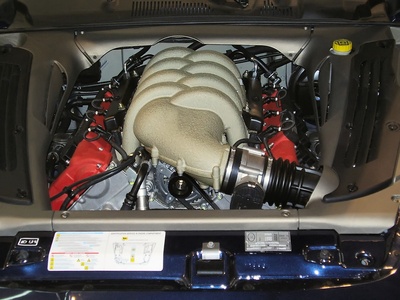
The water pump circulates coolant through the 2001 Ford Taurus engine, and is a vital component for its smooth operation. Coolant leaking from the block, a wobbling water pump pulley or overheating are signs the pump might be defective. Make repairs immediately, or the engine could be irreparably damaged.
A 3.0L V6 engine is standard equipment for the 2001 Taurus model year. The engine is mounted sideways within the engine compartment, as in most front-wheel-drive cars. The water pump is located on the passenger's side of the engine, where access is limited, so several components must be removed to make this repair.
Park the car on a level surface, engage the parking brake and turn the engine off.
Chock the wheels.
Open the hood and disconnect the negative battery cable. When the engine has cooled, remove the radiator cap.
Place a large drain pan under the passenger’s side of the radiator.
Loosen the lower radiator hose clamp with pliers or a screwdriver as needed. Slowly slide the hose away because the coolant will surge out. Allow all the coolant to drain into the pan. Disconnect the small hose connecting the coolant overflow tank to the top of the radiator, and remove the overflow tank.
Look on the fan shroud for the drive belt routing label. Make a sketch of the belt configuration if this label is not visible. A diagram of the proper drive belt routing can also be printed from an online source such as the AutoZone website.
Loosen the water pump pulley bolts just enough to break the tension.
Place the socket wrench over the belt tensioner nut and pull upward to create slack in the belt. Slip the belt off the pulley with your other hand and gently lower the tensioner. Remove the tensioner and the drive belt.
Remove the water pump pulley, and disconnect the hose from the pump.
Unscrew the retaining bolts and pull away the water pump and gasket.
Gently scrape away any remaining gasket material.
Allow the remaining coolant to drain away for several minutes.
Wipe oil or grime from around the pump opening.
Spread gasket sealant onto the new water pump’s mounting surface and to the engine side of the gasket. Apply a thin coat of clean engine oil or spray lubricant to all the bolts and studs except the bolt that goes into the bottom hole.
Insert two bolts on opposite sides of the pump. Slide the pump with the two bolts into place against the engine. Hand-tighten the bolts. Insert all the remaining bolts except the bottom-most bolt, and hand-tighten them.
Apply a thin coat of gasket sealant to the bottom-most bolt, place it in the remaining hole and hand-tighten. Use the torque wrench in a crisscross pattern to secure the bolts. Apply 18 foot-pounds of torque to the upper 8-mm bolts and 89 inch-pounds or 7 foot-pounds to the lower 6-mm bolts.
Reconnect the coolant hose to the pump. Tighten the water pump pulley with a socket wrench until it's snug. Attach the drive belt tensioner. Route the drive belt to its proper position using the diagram or sketch. Tighten the water pump pulley bolts with 30 to 100 foot-pounds of torque.
Reinstall the coolant tank. Attach the lower radiator hose and tighten the clamp.
Fill the radiator with a 50/50 mix of antifreeze and water. Fill the radiator slowly, checking the water pump and hoses for leaks. Close the radiator cap.

Reconnect the negative battery cable. Start the engine and allow it to idle for 10 minutes. Turn off the engine, and recheck the torque on the water pump bolts if there is leakage.